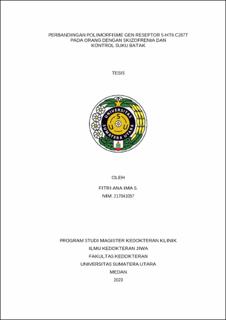| dc.description.abstract | Background: Schizophrenia is a chronic mental disorder that affects human psychosocial functioning. Approximately, 24 million people worldwide are estimated to suffer from this disorder, with the onset typically occurring in late adolescence or early twenties. People With Schizophrenia (PWS) have a higher risk of premature death, in which the development is influenced by environmental and psychological factors. Furthermore, the serotonin system plays an important role in the pathogenesis of schizophrenia, and the serotonin 5-HT6 receptor gene is associated with its development. The "serotonin-dopamine" hypothesis states that an increase in dopaminergic and serotonergic neurotransmission in subcortical areas as well as a decrease in activity in the prefrontal cortex cause positive and negative symptoms.
Methods: This study used an analytical comparative method with an observational analysis design. The samples were selected using consecutive non-probability sampling, with a total of 145 PWS patients and 145 healthy controls from the Batak ethnic group. The analytical tests used were Chi-Square and logistic regression.
Results: The PWS group was dominated by male subjects with 93 people (64.1%), while in the healthy control group, there were 126 males (86.9%). The median age was 35 years and 24 years in both groups respectively. The median onset of disease in the PWS group was 25 years, and the median length of disease was 8 years. The T allele was the most frequently found in the PWS group, with 218 occurrences (75.2%), while in the control, it was found 216 times (74.5%) with a p-value of 0.84. In the logistic regression analysis, the p-value for genotypes CC vs TT and CT vs TT was 0.673 and 0.963 respectively.
Conclusion: This study did not find a relationship between the 5-HT6 C267T gene with schizophrenia in the Batak ethnic group and their control group. | en_US |


